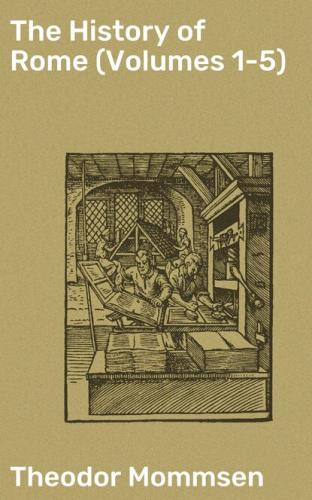If we further inquire how this traffic was mainly carried on, whether by Italian merchants abroad or by foreign merchants in Italy, the former supposition has all the probabilities in its favour, at least so far as Latium is concerned. It is scarcely conceivable that those Latin terms denoting the substitute for money and the commercial loan could have found their way into general use in the language of the inhabitants of Sicily through the mere resort of Sicilian merchants to Ostia and their receipt of copper in exchange for ornaments. Lastly, in regard to the persons and classes by whom this traffic was carried on in Italy, no special superior class of merchants distinct from and independent of the class of landed proprietors developed itself in Rome. The reason of this surprising phenomenon was, that the wholesale commerce of Latium was from the beginning in the hands of the large landed proprietors—a hypothesis which is not so singular as it seems. It was natural that in a country intersected by several navigable rivers the great landholder, who was paid by his tenants their quotas of produce in kind, should come at an early period to possess barks; and there is evidence that such was the case. The transmarine traffic conducted on the trader's own account must therefore have fallen into the hands of the great landholder, seeing that he alone possessed the vessels for it and—in his produce—the articles for export.(28) In fact the distinction between a landed and a moneyed aristocracy was unknown to the Romans of earlier times; the great landholders were at the same time the speculators and the capitalists. In the case of a very energetic commerce such a combination certainly could not have been maintained; but, as the previous representation shows, while there was a comparatively vigorous traffic in Rome in consequence of the trade of the Latin land being there concentrated, Rome was by no means essentially a commercial city like Caere or Tarentum, but was and continued to be the centre of an agricultural community.
Notes for Book I Chapter XIII
1. I. II. Agriculture
2. I. III. Clan Villages, I. V. The Community
3. The system which we meet with in the case of the Germanic joint tillage, combining a partition of the land in property among the clansmen with its joint cultivation by the clan, can hardly ever have existed in Italy. Had each clansman been regarded in Italy, as among the Germans, in the light of proprietor of a particular spot in each portion of the collective domain that was marked off for tillage, the separate husbandry of later times would probably have set out from a minute subdivision of hides. But the very opposite was the case; the individual names of the Roman hides (-fundus Cornelianus-) show clearly that the Roman proprietor owned from the beginning a possession not broken up but united.
4. Cicero (de Rep. ii. 9, 14, comp. Plutarch, Q. Rom. 15) states: -Tum (in the time of Romulus) erat res in pecore et locorum possessionibus, ex quo pecuniosi et locupletes vocabantur—(Numa) primum agros, quos bello Romulus ceperat, divisit viritim civibus-. In like manner Dionysius represents Romulus as dividing the land into thirty curial districts, and Numa as establishing boundary-stones and introducing the festival of the Terminalia (i. 7, ii. 74; and thence Plutarch, -Numa-, 16).
5. I. XI. Contracts
6. Since this assertion still continues to be disputed, we shall let the numbers speak for themselves. The Roman writers on agriculture of the later republic and the imperial period reckon on an average five -modii- of wheat as sufficient to sow a -jugerum-, and the produce as fivefold. The produce of a -heredium- accordingly (even when, without taking into view the space occupied by the dwelling-house and farm-yard, we regard it as entirely arable land, and make no account of years of fallow) amounts to fifty, or deducting the seed forty, modii. For an adult hard-working slave Cato (c. 56) reckons fifty-one -modii-of wheat as the annual consumption. These data enable any one to answer for himself the question whether a Roman family could or could not subsist on the produce of a -heredium-. The attempted proof to the contrary is based on the ground that the slave of later times subsisted more exclusively on corn than the free farmer of the earlier epoch, and that the assumption of a fivefold return is one too low for this earlier epoch; both assumptions are probably correct, but for both there is a limit. Doubtless the subsidiary produce yielded by the arable land itself and by the common pasture, such as figs, vegetables, milk, flesh (especially as derived from the old and zealously pursued rearing of swine), and the like, are specially to be taken into account for the older period; but the older Roman pastoral husbandry, though not unimportant, was withal of subordinate importance, and the chief subsistence of the people was always notoriously grain. We may, moreover, on account of the thoroughness of the earlier cultivation obtain a very considerable increase, especially of the gross produce—and beyond doubt the farmers of this period drew a larger produce from their lands than the great landholders of the later republic and the empire obtained (iii. Latium); but moderation must be exercised in forming such estimates, because we have to deal with a question of averages and with a mode of husbandry conducted neither methodically nor with large capital. The assumption of a tenfold instead of a fivefold return will be the utmost limit, and yet it is far from sufficing. In no case can the enormous deficit, which is left even according to those estimates between the produce of the -heredium- and the requirements of the household, be covered by mere superiority of cultivation. In fact the counter-proof can only be regarded as successful, when it shall have produced a methodical calculation based on rural economics, according to
